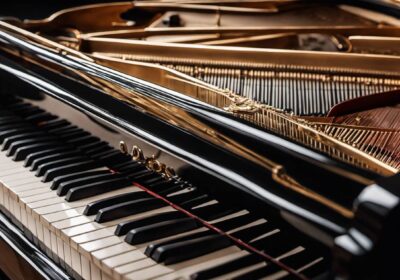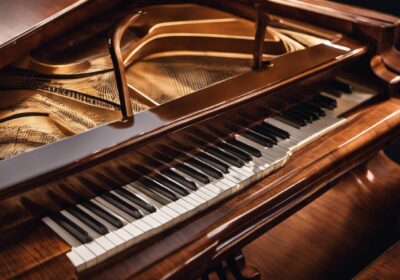Imagine walking into a party and immediately captivating everyone’s attention the moment you start playing the piano. Learning to play this majestic instrument can seem complex and overwhelming but fear not, it’s easier than you might think! This beginner’s guide will walk you through the basics of piano playing, introducing easy-to-learn and practice techniques. It’s time to awaken the maestro within you and embark on an exciting journey towards becoming an accomplished pianist. Stay tuned; your musical adventure is about to begin.
The basics of piano playing include learning how to read sheet music, proper hand posture and positioning, and practicing scales and chord progressions. As you progress in your studies, you will learn more advanced techniques, such as dynamics, phrasing, and pedal usage. It is important to have a well-rounded approach to your practice routine that includes both technical exercises and repertoire building to become a skilled pianist.

Exploring the Piano
Before diving into the world of piano playing, it’s important to familiarize yourself with this beautiful instrument. The piano consists of 88 keys, which are made up of both black and white keys arranged in a repeating pattern. The arrangement of keys follows a specific order, starting with A and ending with C. If you’ve never played before, imagine sitting in front of the piano, your fingers hovering over the keys, ready to create music. It’s like entering a new world filled with endless possibilities and melodies waiting to be discovered.
- Before starting to play the piano, it is important to have a basic understanding of the instrument. The piano consists of 88 keys arranged in a repeating pattern, and familiarizing oneself with its arrangement can help with piano playing. Playing the piano offers unlimited potential for musical creativity.
Instrument Familiarization
To make the most out of your piano journey, take the time to familiarize yourself with its various components. An important feature is the keyboard, which comprises black and white keys. The white keys are called naturals and represent seven different notes: A, B, C, D, E, F, and G. You can think of these as stepping stones that form the foundation of music theory. In between these white keys are the black keys known as accidentals or sharps/flats. These allow for playing additional notes and creating different harmonies.
Another crucial component is the pedals located at the bottom of the piano. The rightmost pedal is called the sustain pedal or damper pedal. Pressing this pedal allows certain notes to ring out while you continue playing others. Meanwhile, the leftmost pedal is known as the soft pedal or una corda pedal. When engaged, it reduces the volume and alters the tone of the piano, providing a softer sound.
Understanding these fundamental aspects of a piano will help you navigate through lessons and exercises more effectively. Take some time to explore each key’s unique sound by pressing them gently and listening attentively to their distinct tones.
Now that we have explored the different components of a piano and gained familiarity with its keyboard layout and pedals, we can move forward in our journey to understanding the basics of piano playing.
Keys and Chords
Before diving into the fundamentals of piano playing, it’s crucial to understand the basics of keys and chords. Keys refer to the different notes on the piano, which are represented by white and black keys. The keyboard consists of 88 keys, with each key representing a specific pitch or musical note.
Keys are organized into a repeating pattern known as an octave. The most fundamental keys on a piano are C, D, E, F, G, A, and B. These keys make up the white keys on the keyboard. The black keys, also known as sharps or flats, represent notes that lie between these fundamental keys.
Chords, on the other hand, are combinations of multiple notes played simultaneously. They provide harmony and depth to music. Common types of chords include major chords (happy-sounding), minor chords (sad-sounding), and diminished chords (tense-sounding).
It’s important to have a solid understanding of keys and chords as they form the foundation for playing melodies, harmonies, and even improvisation on the piano. Now that we’ve covered this groundwork let’s move on to exploring the fundamentals of piano playing.
- According to a National Association for Music Education report, 80% of adults wish they had learned to play a musical instrument, and the piano commonly ranks among the most desired.
- Studies have shown that learning to play an instrument like the piano at a young age can boost IQ by up to 7 points in both children and adults.
- A study published in Psychology of Music found that structured music learning can significantly enhance children’s cognitive abilities, including language-based reasoning and short-term memory.
Fundamentals of Piano Playing
When starting your journey into piano playing, it’s crucial to grasp the fundamentals. These building blocks will help you lay a strong foundation for your musical endeavors.
First and foremost is posture. Maintaining proper posture allows for comfort while playing and helps avoid unnecessary tension and strain in your hands and body. Sit straight with relaxed shoulders and arms at a comfortable distance from the keyboard.
Next is hand positioning. Place your hands on the keyboard with curved fingers and relaxed wrists. Keep your thumb centered under your palm while placing your other fingers naturally on the keys.
Moving onto sight-reading techniques. Learning how to read sheet music is essential for piano players. Familiarize yourself with the musical staff, notes, and rhythm notations. Practice reading simple melodies and gradually progress to more complex pieces.
Practice scales, which are sequences of notes played consecutively, in different keys. This helps develop finger dexterity, hand coordination, and familiarizes you with the layout of the piano keyboard.
Another essential aspect is rhythm. Develop a sense of timing by practicing various rhythms using metronomes or backing tracks. It enables you to play music accurately and in sync with other musicians.
Lastly, it’s vital to learn proper technique for producing quality sound. This includes understanding concepts like dynamics (playing softly or loudly), articulation (playing staccato or legato), and pedal usage.
Remember, consistent practice is key to mastering these fundamentals. Dedicate time each day to practice and be patient with yourself as progress takes time. Celebrate each milestone along the way and have fun exploring the vast world of piano playing.
Sight-Reading Techniques
When starting your journey as a pianist, one of the essential skills to develop is sight-reading. This involves being able to play music from sheet music without prior practice or familiarity with the piece. Sight-reading allows you to explore a wide range of music and provides the foundation for learning new pieces efficiently.
To enhance your sight-reading skills, it is crucial to focus on a few key techniques:
- Scanning: Begin by scanning the piece before you start playing. Look for any challenging sections, unfamiliar rhythms, or complex passages. This initial scan helps familiarize yourself with the overall structure and requirements of the piece.
- Note Recognition: Train your eyes to recognize notes quickly. Practice identifying notes on the staff and associating them with their corresponding keys on the piano keyboard. This will help you read music notation more fluently.
- Rhythm Awareness: Pay close attention to rhythm patterns and time signatures within the sheet music. Develop a sense of pulse and internalize common rhythmic figures such as quarter notes, eighth notes, and rests.
- Chord Recognition: Learn common chord progressions and understand how they are represented in sheet music. Recognizing chords can help you anticipate harmonies and improve your overall playing accuracy.
With consistent practice and exposure to various musical styles, your sight-reading abilities will continue to develop, enabling you to learn new pieces more efficiently.
Stroke and Hand Positioning
Another fundamental aspect of piano playing is mastering stroke and hand positioning techniques. Proper hand position ensures optimal control over the keyboard and helps prevent unnecessary tension or strain while playing.
Here are some guidelines for stroke and hand positioning:
- Natural Hand Shape: Maintain a natural curve in your hands while placing them on the piano keys. Avoid excessive tension or collapsing the fingers, as this can hinder fluid movement.
- Relaxation: Aim for a relaxed hand and arm position to allow for smooth and effortless playing. Avoid unnecessary tension in your muscles, particularly in the wrists and fingers.
- Finger Placement: Position your fingers on the keys with the fingertips, not the pads. This allows for better precision and control while playing.
- Wrist Alignment: Keep your wrists aligned with your forearms, neither excessively raised nor drooping downwards. Maintaining a neutral wrist position helps promote fluid finger movement.
- Arm Weight: Utilize the weight of your arms to produce a sound rather than relying solely on finger strength. This technique contributes to a more balanced and controlled approach to playing.
By practicing stroke and hand positioning consistently, you will develop good habits that promote efficient technique and prevent injury or strain over time.
Enhancing Playing Skills
As a beginner pianist, it’s important to focus on enhancing your playing skills. This involves developing techniques and refining your ability to play the piano with precision and musicality. One fundamental aspect to pay attention to is proper hand posture and positioning on the keys. Remember to keep your wrists relaxed and maintain a curved hand shape, which allows for better control and agility when playing.
Another crucial skill to cultivate is sight-reading. This involves being able to read sheet music and translate it into sound on the piano in real-time. Start with simple pieces and gradually progress to more complex compositions, practicing regularly to improve your reading fluency.
Playing with dynamics is yet another facet of enhancing your playing skills. Experiment with varying levels of volume, emphasizing certain notes or phrases to bring out the musical expression in a piece. Learning how to control the intensity of your playing adds depth and emotion to your performance.
Lastly, don’t forget about rhythm! Developing a strong sense of rhythm will help you stay in time while playing and create a solid foundation for your musicality. Practice rhythmic exercises, counting beats out loud, and using a metronome to improve your timing accuracy.
Remember, enhancing your playing skills is an ongoing journey that requires consistent practice, dedication, and patience. Be open to feedback from teachers, fellow musicians, or even recordings of yourself playing as you strive for continuous improvement.
Song Memorization Strategies
When learning piano, one challenge many beginners face is memorizing songs. Whether you’re working on a classical composition or a popular tune, having effective memorization strategies can greatly enhance your overall performance.
One proven method is breaking the piece down into smaller sections or phrases. By focusing on one phrase at a time, you can isolate difficult passages or intricate rhythms and work on them diligently until they become more comfortable. Once each section feels secure, gradually piece them together to form the complete song.
Let’s say you’re learning a new jazz piece with a challenging melody. Start by practicing the first four measures until you can play them confidently. Then move on to the next four measures, and so on. Eventually, you’ll be able to connect each section seamlessly, solidifying your memorization of the entire song.
Additionally, incorporating visualization techniques can aid in song memorization. As you practice, try visualizing yourself playing the piece from memory, imagining the hand movements and key presses. This mental rehearsal can reinforce your muscle memory and make recalling the music easier during a performance.
Another effective strategy is practicing away from the piano. Take advantage of downtime or moments where you can’t access an instrument to mentally go through the song in your mind. This helps reinforce your memory and keeps the music fresh in your mind.
Just like learning lines for a play or memorizing lines of dialogue, repetition and focused practice are key to ingraining the music into your memory.
By combining these strategies, breaking down the piece into manageable sections, visualizing your performance, and practicing away from the piano, you’ll improve your ability to memorize songs more effectively.
The Power of Practice
When it comes to learning any new skill, including piano playing, practice is the key to progress and mastery. The power of consistent practice cannot be emphasized enough. It is through regular and focused practice sessions that you build muscle memory, develop technical skills, and refine your musicality. **** Think of it as training for a marathon – the more you practice, the stronger and more proficient you become.
However, it’s important to understand that not all practice is created equal. Mindless repetition or playing through pieces without intention will yield limited results. Effective practice involves setting specific goals for each session and breaking down challenging passages or techniques into smaller, manageable parts. By focusing on these specific areas, you can make targeted improvements and gradually overcome any hurdles.
Now that we understand the power of practice, let’s explore an essential aspect of piano playing – daily warm-up routines.
Daily Warm-Up Routines
Just like athletes warm up their muscles before intense physical activity, pianists should also warm up their fingers and hands before diving into practice or performance. **** Imagine jumping straight into a difficult piece without properly warming up; your fingers might feel stiff and uncoordinated, hindering your ability to play at your full potential.
Taking inspiration from an athlete stretching routine or doing agility drills before a race; when pianists incorporate a daily warm-up routine into their practice session, they can improve finger dexterity, flexibility, accuracy, and overall coordination.
A typical warm-up routine may include exercises such as finger stretches, hand arches, scales, arpeggios, or simple finger patterns. These exercises help to loosen up the muscles in your hands and promote blood circulation. They also serve as mental preparation by helping you focus and establish proper technique from the very beginning of your practice session.
By regularly incorporating a warm-up routine into your piano practice, you set the stage for productive and efficient practice sessions. Not only does it help prevent injury and promote healthy playing habits, but it also prepares your mind and body to tackle more challenging pieces or techniques with greater ease and confidence.
Now that we’ve discussed the importance of practice and daily warm-up routines, let’s dive deeper into other fundamental aspects of piano playing, including technique, rhythm, sight-reading, and repertoire selection.



